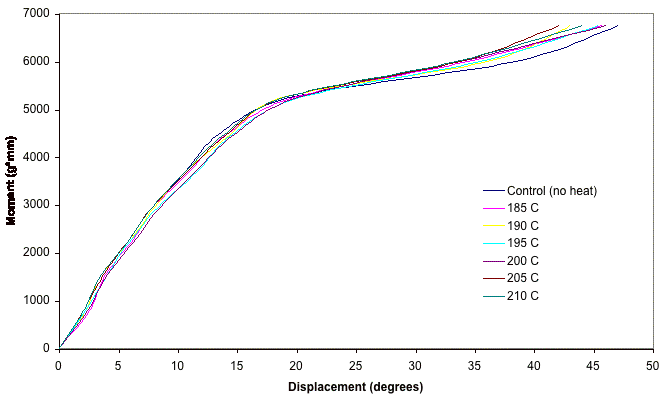ABSTRACT: 0043
Polyphenylene Orthodontic Wire Properties Unaltered by Thermoforming Conditions
| A.J. GOLDBERG, K.A. ECKROTE, and C.J. BURSTONE, University of Connecticut Health Center, Farmington, USA | ||||
Introduction: Recently developed polyphenylene thermoplastics possess sufficient instantaneous mechanical properties for orthodontic archwire applications. Additionally, the wire's tinted translucency would allow for aesthetics. However, the thermoforming operations necessary to form clinically relevant shapes could affect the properties of these extruded small cross-sectional wires. Objectives: Determine the appropriate time and temperature conditions for thermoforming and the effect of these processing conditions on flexure properties. Methods: Semi-rigid backbone polyphenylene (Parmax 1200, MPT) was extruded into round wires nominally 1mm in diameter. The glass transition temperature, Tg, was determined with differential scanning calorimetry, DSC (Q100, TA Instruments), n=3. Then, straight lengths were heated to 25o-50oC above Tg and held for 15 minutes. In a second series wires were held at Tg+30oC for time periods of 10 to 80 minutes. Samples were cooled to RT and flexure properties were evaluated under simulated clinical loading using a 5mm free-end cantilever span (n=3). Results were compared with ANOVA. Results: Mean (sd) Tg was 157.3 (2.9)oC, consistent with literature values of 158oC. DSC plots gave no indications of ordered structures, potentially resulting from extrusion. There were no statistically significant changes (p > 0.05) in flexure properties with heating at the thermoforming temperatures (shown below) and times. Flexure properties were not statistically different from unheated controls and had maximum moments of approximately 6000 gm-mm and stiffnesses of 370 gm-mm/degree. All samples maintained their tinted, translucent appearance and a well-defined circular cross section. Arch forms were successfully produced by holding a polyphenylene wire in a matched-die aluminum mold at 200oC for 15 minutes. Conclusion: Following extrusion to cross-sectional sizes relevant for orthodontics polyphenylene wires showed no change in flexure properties when subjected to the time and temperature cycles necessary to form archwires and springs.
| ||||
| Seq #12 - Wires for Rotary Instruments, Orthodontic Wires, and Bonding 2:15 PM-3:45 PM, Wednesday, July 2, 2008 Metro Toronto Convention Centre Room 803A | ||||
|
Back to the Dental Materials 7: Metal-based Materials Program | ||||
©Copyright 2008 American Association for Dental Research. All Rights Reserved.
